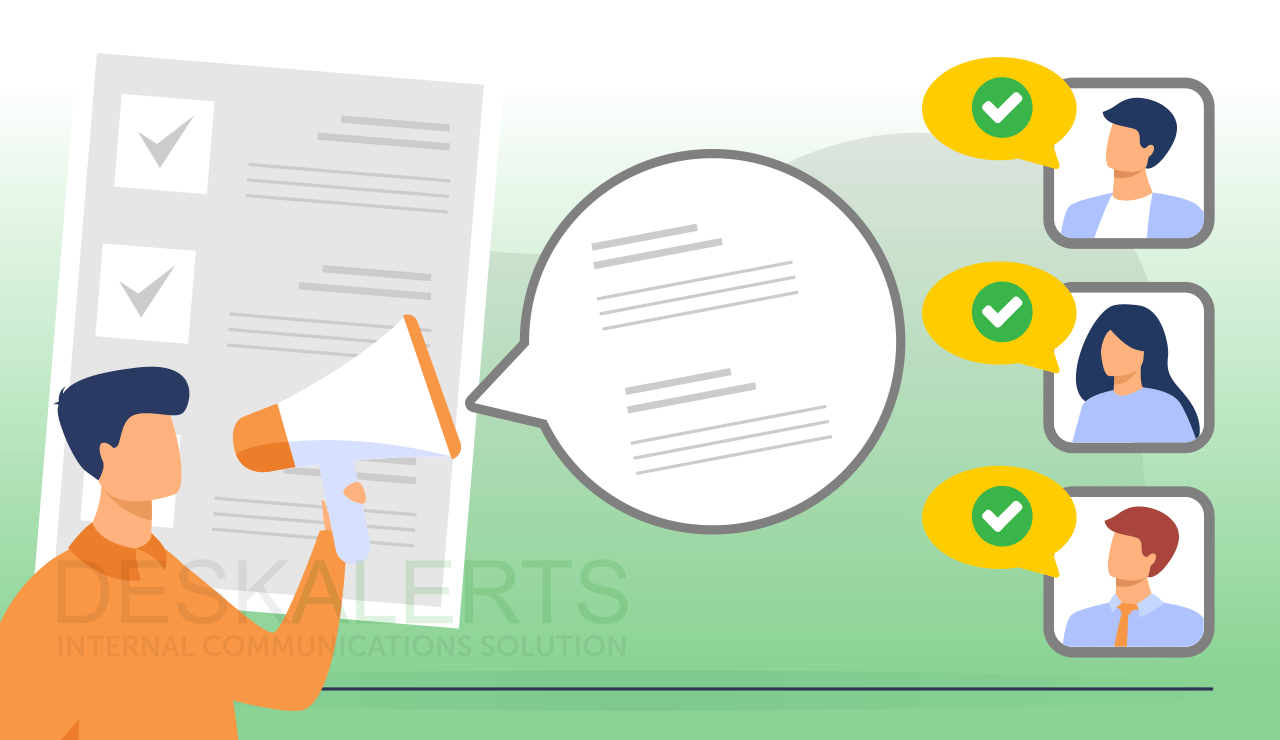13 min read
Top Internal Communication Trends in 2025 and How Businesses Are Adapting [+ Examples]
Historically, internal communication tracked engagement metrics like email open rates, clicks, or survey participation. However, in 2025, the focus...
5 min read
 Caroline Duncan
:
Sep 15, 2022 8:15:00 AM
Caroline Duncan
:
Sep 15, 2022 8:15:00 AM

Internal communication is important in every company to ensure that people understand key happenings that affect the organization. Strong internal communications also help to boost morale, improve levels of employee engagement, and in turn, benefit productivity and profitability.
If you’re not pulling out all the stops possible to ensure information flows well within your company, your competitors who do internal communications well will always have a jump on you.
Table of contents
Modern internal communications challenges
What can you do to encourage employees to read announcements?
The best way to share information with employees
Internal communications can be a very challenging space to operate in: how do you reach everyone with the information they need at the right time? These are the main challenges:
The average employee receives hundreds of emails every week – and most of them sit in inboxes unopened and unread. Internal communicators who rely heavily on this channel are setting themselves up to fail.
A survey from SlickText found that 60.8% of people admit they ignore emails at work!
In today's fast-paced business environment, internal communicators are competing against lots of other digital distractions and notifications that are vying for employees’ attention, meaning that important information may not be getting through.
It isn’t just emails: people are bombarded with notifications all day long, both in their personal and professional lives. Instant messengers, group chats, comments, text messages, phone calls and more. It can be easy for your messages to get lost in among all the other noise.
According to the Information Overload Research Group, 28% of a typical knowledge worker’s day is spent dealing with these distractions.
Timeliness is one of the most important tenets of communication. It ensures that people are acting on the most up-to-date information so that they can take appropriate steps based on it.
Unfortunately, many organizations don’t communicate in a timely manner. This can be because information gets caught up in lengthy approvals processes before being released, managers don’t understand the importance of releasing information in a timely manner or they prioritize external communications over internal communications.
In some cases, the first time employees may hear information about their company is from the outside world, which can lead to loss of trust and disengagement. Other times taking too long to send out official information can create a void that is filled with speculation, misinformation and rumors. And other times, even if you have communicated quickly, by the time people see the email or read your intranet content, a lot of time may have passed.
Sadly, just 7% of US workers told a Gallup poll that they feel the communication in their workplaces is timely, open and transparent.
There are lots of different factors at play that can influence the make-up of a company’s structure. Not every employee sits at a desk in an office building. There are many non-desk workers involved in retail, hospitality, construction, healthcare, manufacturing, logistics, agriculture and emergency work: just to name a few.
>> Learn how to improve internal communications in hotels with an app for hotel employees <<
According to Emergence Capital, around 80% of the global workforce are deskless employees.
The number of employees engaged in remote work has increased rapidly since the COVID-19 pandemic began. Many people are now working from home some or all of the time when they previously worked from an office.
>> Want to communicate better with remote staff? Check out these tips <<
Reaching people with information that they need in a way that ensures they will not only receive it in the first place, but want to engage with it is the main goal for every internal communicator. Try these internal communication ideas to help to make that a reality:
Evaluate the channels that you currently use.
Are they fit for purpose?
Are they able to cut through the digital noise in your organization and reach people when you have to communicate urgently?
Using a multi-channel approach to communications you can use certain channels for important or urgent communications – for example, sending pop-up notifications with DeskAlerts, and keeping other channels like email or group chats for less time critical information.
If you’re sending out too much information all the time, your internal comms will become added digital noise and distractions that employees will start to tune out. Only communicate when you need to.
Discourage people from using “reply all” to send one word answers on emails.
Streamline your team communication channels. Avoid burdening employees with irrelevant information by creating custom audiences and sending information on niche topics only to those who need to receive it.
>> Learn more about the power of targeting and audience segmentation in internal communications <<
You know the saying, first impressions count. This definitely applies to your internal communications: if you have an attention-catching and easy-to-understand headline, use graphics and video and make your content interactive where possible, you have more chances of people both noticing and engaging with your content. It should also be obvious to the person receiving the content what is “in it” for them and why you’ve sent it to them.
Interactive content such as surveys, polls and quizzes helps people to engage with your communications. If people are thinking about the content before they provide an answer, they’re more likely to remember what you told them. Use personalization wherever possible. Encouraging emails to employees that acknowledges them and the work they do can also engage them.
Mobile technology has made it easier than ever before to reach and engage with staff who do not work in a “desk job”. Previously you would have to send pager messages, faxes, put memos on notice boards and trust middle managers to pass on important information to employees who work in non-office environments. Today you can use apps to communicate with employees, sending them push notifications about important information and letting them engage with their peers from across the company.
Your content should be easy to understand, communicated in plain language and free from jargon. People don’t want to read slabs of text, so make sure that your message is short and sweet and gets straight to the point.
DeskAlerts is an internal communication software solution that is installed on corporate devices such as desktops, laptops, mobile phones and tablets. You can reach any employee no matter where they are working.
DeskAlerts features different channels that can be used for urgent and important information, bypassing the email system and guaranteeing a 100% read rate.
Messages appear on screens in a way that can’t be skipped or ignored.
Tools include pop-up notification, corporate screensavers and wallpapers, digital signage displays and scrolling desktop tickers. An employee app also sends push notifications to smartphones and tablets.
Messages can be scheduled to send in advance and can be sent to the entire company at once or to targeted audience segments.
Other features like RSVPs, surveys, polls and quizzes round the package out so that you can always be sure people know about important happenings within your company.
***
If you’ve been struggling to cut through with your internal communications, we really believe DeskAlerts will be a breath of fresh air in your organization. Get in touch with our experts today for a free demo to see how DeskAlerts can transform your workplace.
Employees are more likely to read your communication if it is set out well, has an engaging title, is written in simple language and is brief.
There are several ways you can encourage employees to read your company newsletters.
These include:
You can encourage employees to read your emails by:
Employees can sometimes feel shy, uncertain or even intimidated about coming forward and sharing ideas. Sending anonymous polls and surveys can be a good way to circumvent this so people can feel free to make constructive suggestions.
Research has found that employees are increasingly overwhelmed and overburdened by email and many emails are not opened or read.
![Top Internal Communication Trends in 2025 and How Businesses Are Adapting [+ Examples]](https://www.alert-software.com/hubfs/Top%20Internal%20Communication%20Trends%20in%202025.png)
13 min read
Historically, internal communication tracked engagement metrics like email open rates, clicks, or survey participation. However, in 2025, the focus...

14 min read
You could have the best communication strategy for change management, the right tools, and a clear business case, but if your employees don’t...

14 min read
Martyn’s Law will change how UK venues prepare for terrorist threats as it requires businesses to take proactive security measures to protect the...

8 min read
When you need to communicate with your employees, you’ll get the best results if you communicate with the right people in the right place at the...

5 min read
Corporate events are a great way to bring your team together from across the organization for informal networking, sharing of ideas, celebrating...

4 min read
Keeping your employees informed about important developments within your organization is critical to ensure you have a cohesive team where everyone...